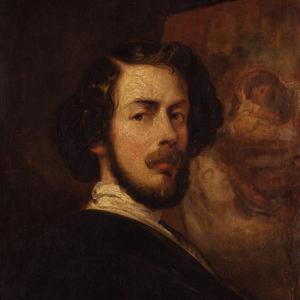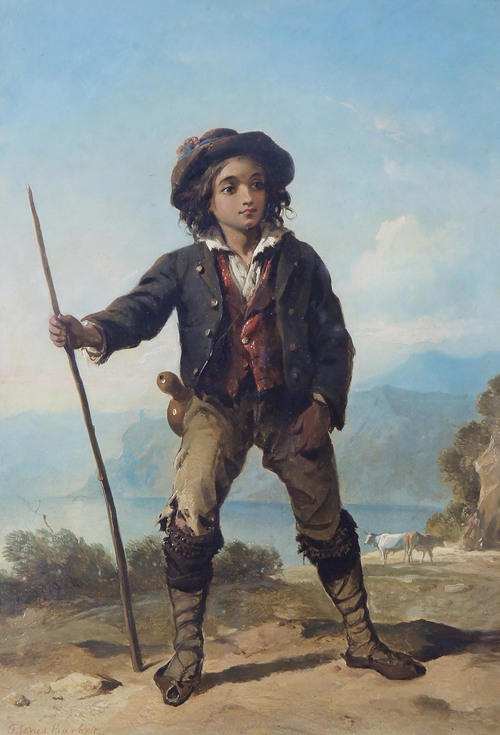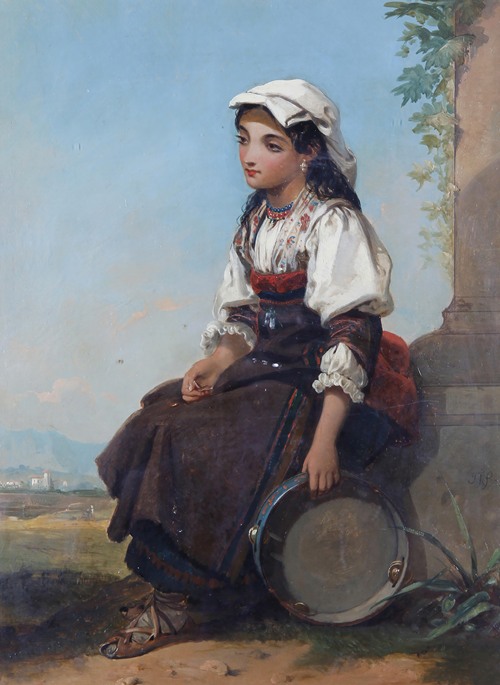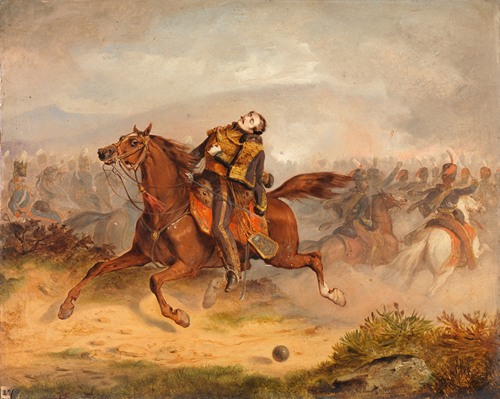

Thomas Jones Barker
Thomas Jones Barker was an English historical, military, and portrait painter.
Thomas Jones Barker was born at Bath in 1815, into a family of artists. His grandfather, Benjamin Barker, was "a failed barrister…who painted horses with limited success" and eventually became "foreman and enamel painter at the japan works, Pontypool, expert at painting sporting and animal figures." His father was the prominent painter Thomas Barker, also called Barker of Bath. His uncles Benjamin Barker, Jr., and Joseph Barker were also painters, as was his younger brother, John Joseph Barker, and his cousin, Marianne A. Barker, daughter of his uncle Benjamin.
After studying under his father, in 1834, at age 19, he moved to Paris and became a student of Horace Vernet. He made his debut at the Paris Salon of 1836 with three paintings, including Beauties of the Court of Charles II, which received a bronze medal. (His father also exhibited in the Salon of 1836.) From 1836 to 1850, Barker showed 28 paintings at the annual Paris exhibition.
A dozen of those paintings depicted hunters, poachers, dogs, and game. Barker's earliest known work, a collaboration with his father from 1834, depicted a boy guarding game while his father, in the distance, goes about hunting with a rifle and dog. This early and enduring interest in hunting and in dogs provides a rare glimpse into Barker's personal life. In Paris, Barker had a dog named Mentor who appears in some of his paintings.
Barker's work was so well received in France that he was invited to meet King Louis Philippe I and was given two royal commissions. For these works, the king conferred on Barker the Cross of the Légion d'honneur. The first royal commission was a large painting depicting the death of Louis XIV at Versailles; this painting disappeared in the sack of the Palais Royal in the French Revolution of 1848. An oil on cardboard sketch for the work, made on the spot for the king, is in the collection of the Musée Antoine Lécuyer in Saint-Quentin, France.
Barker's second royal commission was for the king's daughter, Princess Marie; the painting La finacée de la mort (The Bride of Death) was completed in 1839 and was shown at Paris Salon of 1841.
Barker's Parisina, one of three paintings he exhibited at the Paris Salon of 1842, exemplifies several of the influences on his work while in France—the historical drama and vivid detail of his teacher, Vernet.
Barker returned to England in 1845. From that year to 1876, he exhibited 29 paintings at the Royal Academy. He achieved his greatest success as a military painter, both historical and contemporary. Some of his earliest military paintings were scenes from the Napoleonic Wars, including his 1853 Royal Academy piece Wellington at Sorauren.
In 1870, Barker observed on the spot the Franco-Prussian War, including the Battle of Sedan and the surrender of Napoleon III. It is unclear whether he was a first-hand witness of the Crimean War, but he also exhibited a number of paintings depicting this conflict. An incident from India, The Relief of Lucknow, 1857, completed in 1859, was shown to Queen Victoria in May 1860; heightening the realism were numerous portraits of the chief actors, which Barker based on sketches by Swedish artist Egron Lundgren, who had traveled to India in 1858. Barker made a speciality of painting panoramic images with many figures whose faces were reproduced from actual portraits; when sold as engravings, these would be accompanied by a numbered key identifying the various persons.
Despite his popularity and commercial success, and the fact that he "contributed regularly to the Royal Academy and the British Institution….Barker was not favoured by the art critics of his day, nor was he rewarded with membership of the Royal Academy." He nevertheless occupied a pre-eminent place in a particular niche of British art; a retrospective on his 40-year career written in 1878 began, "If England possessed, what France has at Versailles, a gallery almost expressly devoted to a pictorial record of her military exploits, the artist whose works would find the most prominent place in such a collection would assuredly be Mr. T. Jones Barker, who is certainly the Horace Vernet of England.…We can scarcely pay Mr. Baker a greater compliment…he remains master of the battlefield among English artists."
Throughout his career in England, Barker painted portraits. These included notables such as Disraeli and Garibaldi, but also less exalted figures, as long as they could afford his fees. Barker also specialized in panoramic historical or imaginary gatherings which featured scores of recognizable officials and celebrities, such as The Spa Promenade of 1871.
Barker died at his Hampstead home, 32 Steeles Road, on 27th March 1882 at the age of 68, and was buried in a family grave on the western side of Highgate Cemetery (plot no 15902).


